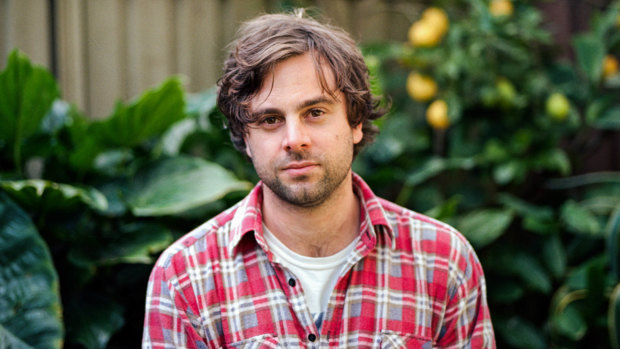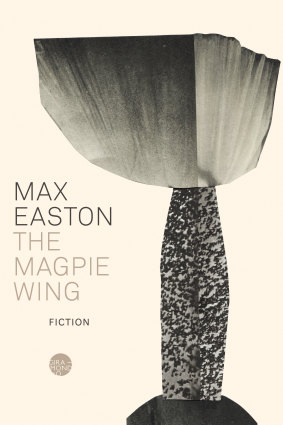This was published 2 years ago
Examining the disappointing shift from childhood innocence to early adulthood
By Declan Fry
FICTION: The Magpie Wing, Max Easton, Giramondo, $26.95
Max Easton’s debut novel, The Magpie Wing, is a character study focused on siblings Helen and Walt and their childhood friend, Duncan. Raised in western Sydney, they look for a world bigger than the one they knew. As Helen and Walt pursue music and Duncan focuses on sport, the novel meditates on the shift from childhood innocence to the disappointments of early adulthood.

Max Easton, author of The Magpie Wing.Credit:
Although Easton cleverly uses bildungsroman elements to frame his narrative, this is a disjointed novel, its origins as a short-story collection still visible. Chapters have a vignette feel, proceeding more like separately observed scenes rather than part of an organic whole – a sense encouraged by the third-person omniscient narration. The most interesting – and perhaps unexpected – aspect of the novel is its brief explorations of Helen and Walt’s bisexuality and queerness. These are tender and thrilling but, having caught the spark of something, Easton does not nurture its flame.
Stylistically, The Magpie Wing is oddly muted. Perhaps the times have changed: the voice-driven work of authors such as Hazzard, Morrison, Bellow and Stead has given way to the subdued and entirely unintrusive narrative voice: Rooney, Moshfegh, Lerner, Heti. This is a novel in which silences are broken, attempts are ham-fisted, stalemates broken, doors stormed through and stares inevitably blank – a novel that is studiously comfortable with cliche.

The Magpie Wing by Max Easton.Credit:
There is also a certain level of comfort with relaying the language of sports and music scenes. Tell a dream, lose a reader, Henry James said. And the dream of sport, if not music, invariably proves difficult to convey on the page. It also places the critic in an invidious position: do they offer, as often occurs in reviews of translations, thoughts on the language, although they may know nothing of music or sport – as with all those Haruki Murakami critics who hasten to inform us how “able” his latest translation is, despite not knowing so much as a baka in Japanese – or do they rely upon preexisting acquaintance, if not hours of swotting, to arrive at an informed critique?
Such a path risks forgetting that the first rule of narrative description is to have the technicalities of a given subject – cooking, card games, whaling – disappear, ideally, into the accommodations of the prose. When Easton writes, for example, that “while Duncan saw a perfect union, Walt would only ever see the seams”, the imagery recalls sport (and weddings – the seamstress, the tailor); but a line about how “[t]heir strengths and weaknesses dovetailed” feels jarring in the context of the two boys receiving magpie tattoos – had “matched” replaced “dovetailed”, the sports reminder would only have been repeated.
Here, the avowal of a truism may be in order: art is not life.
Helen, the character The Magpie Wing feels most invested in, harbours a furious distaste for contemporary life and hipsters, dubbing those around her variously “self-proclaimed”, “self-important”, and “self-involved”. Yet there is no resolution for her, or for any of the characters; the narrative remains cynical and pervaded by a bitter futility.
This would not necessarily be a problem, except that Easton has explicitly predicated the personalities of Helen and Walt on the struggle against cynicism, the hope of finding something beyond self-absorption or smarter-than-thou hipsterdom. There is a wonderful moment when Helen is talking to her partner, Suze, and tells her, “I’m sorry I’m like this”. The melodrama is punctured beautifully when Suze responds: “No, you’re not.” It feels like the promise of a struggle toward redemption or breakthrough, but instead becomes a pat statement of fact – a note that feels, for all its emotional resonance, hastily drawn.
Some might call this lack of resolution “lifelike” or “just like life”. This appraisal misunderstands the modus operandi of the realist novel. Realism is not designed to simply repeat or rehearse reality’s mundane aspects, much less relate events purely because it is in the author’s power to do so – as if writing were akin to angling a point-and-shoot camera toward a scene and snapping away.
The goal is to get at something closer to reality – something realer than real – using the mediation of prose and narrative. Dissecting the myriad facts of existence, revealing whatever art and profundity lay beneath: it is a craft we do not always recognise, but it is intrinsic to the dream of realism and its various modes, to always seek what cannot be recognised by day, exposing it to the light – the ruthless glare – of art.
This review is supported by the Copyright Agency’s Cultural Fund and the Judith Neilson Institute for Journalism and Ideas.
The Booklist is a weekly newsletter for book lovers from books editor Jason Steger. Get it delivered every Friday.